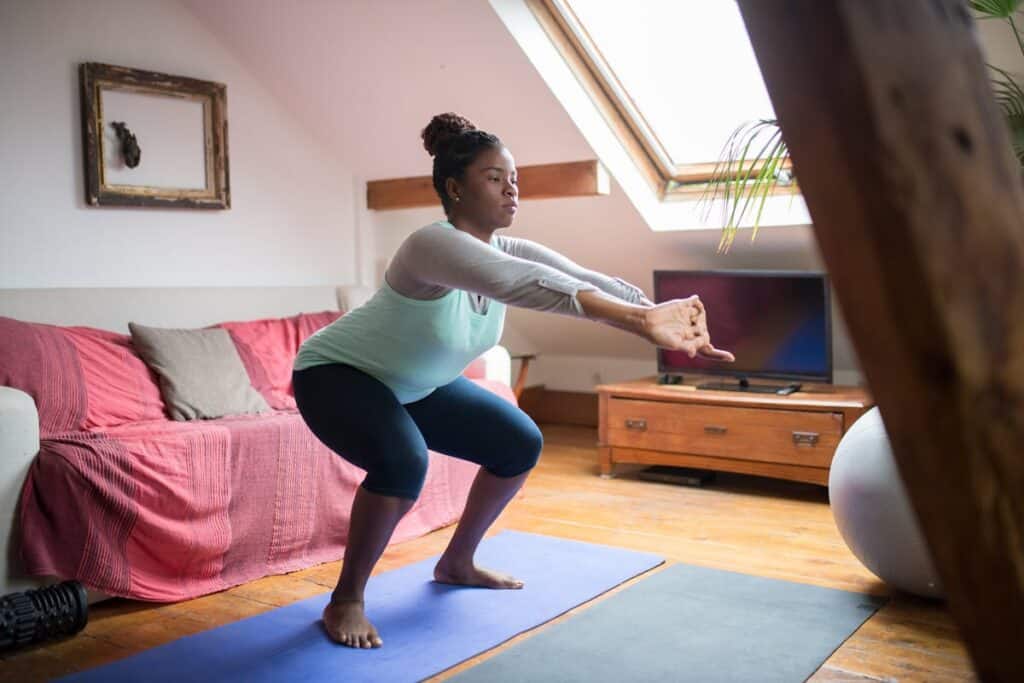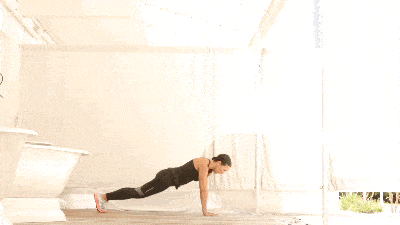
Ever heard of an “exercise snack”? No, it’s not a protein bar you munch on mid-jog. We’re talking about tiny chunks of exercise that pack a mighty punch for your health. Imagine squeezing all the goodness of a full workout into just one or two minutes. Sounds better than trying to find a parking spot at the gym, right? We’re talking quick, fiery bursts of activity that can boost your blood sugar management, and supercharge your cells.
In this article
What are “exercise snacks”?
“Exercise snacks” refer to brief, vigorous periods of physical activity—lasting between one to three minutes—that effectively elevate your metabolic rate. These activities target at least 75% of your maximum heart rate.
Some examples of exercise snacks include:
- Stair climbing
- Desk push-ups
- Chair squats
- Jumping jacks
- Leg lifts
- Wall sit
- High knees
- Arm circles
- Burpees
Many of us sit for a long period of time, whether at our desks or on our couches. The idea of exercising might seem out of reach in these moments. But with exercise snacking you could fit in short bursts of exercise throughout the day to boost your health.
What are the benefits of exercise snacking?
Even though the term and research are fairly new, the concept isn’t. If you’ve ever stood up from your computer or paused your TV to stretch or walk, you’ve done exercise snacking. This quick break method is especially popular among writers and helps refresh both mind and body.
Managing Blood Sugar After Meals
Research shows that just one or two minutes of such vigorous exercise can deliver significant metabolic benefits. A primary effect is the production of lactate, which intensifies muscle activity. This leads to increased blood circulation and lactate absorption by muscles, which then activates glucose transporters to improve glucose uptake, thus enhancing blood glucose levels.
For individuals with type 2 diabetes, timing these “exercise snacks” around meals—either 30 minutes before or after eating—can be particularly effective. This practice dramatically lowers post-meal glucose spikes and improves overall glucose control.
This strategy is also beneficial for anyone looking to maintain steady blood sugar levels after meals, preventing energy and mental clarity dips typically experienced after eating.
Stimulating Mitochondrial Growth
Furthermore, brief sessions of high-intensity interval training (HIIT) of 10 to 20 minutes can powerfully promote the increase of mitochondria in muscle cells. When muscles are pushed beyond their limits and deprived of sufficient oxygen, they switch to an alternative energy-generating process.
This stimulates the production of new mitochondria, a process encouraged by lactate, which acts as a signaling molecule.
Enhancing Longevity Through Daily Activities
Incorporating vigorous activity into daily routines, known as “vigorous intermittent lifestyle activity,” can also significantly extend life expectancy. Activities such as sprinting upstairs instead of walking or adding quick bursts to your daily walk have proven benefits.
Studies using wearable devices have shown that engaging in vigorous physical activity for one to two minutes three times daily can reduce overall mortality by 40% and decrease deaths related to cardiovascular issues by half.
Effective remedy against the hazards of prolonged sitting
Several studies support the idea that we should sit less. Notably, a 2008 study revealed that individuals who sat for extended periods experienced significantly higher rates of blood sugar and cholesterol issues compared to those who frequently stood and moved, regardless of their overall exercise habits.
More recent research indicates that the negative effects of extended sitting on metabolic health are so profound they can nearly negate the benefits of regular exercise.
All-day sitting can harm your health—even with regular workouts. However, exercise snacking can help mitigate the adverse effects of continuous sitting.
As seen in one study, just one day of uninterrupted sitting led to a noticeable decline in the leg muscles’ ability to uptake amino acids from protein consumption, traced with molecular markers.
However, when participants alternated their sitting days with short activities—either walking for two minutes every half-hour or performing a series of chair squats where they stood up, rose onto their tiptoes to engage multiple leg muscles, and then sat back down 15 times—their muscles significantly improved their ability to absorb and use amino acids.
6 Quick and Effective Ways to Fit Exercise Snacks in Your Day
Follow these exercise snacks designed to fit your schedule, no matter how packed it is.
1. Stair Climbing Sprint – 1 Minute Total
Got just a minute? Perfect for a stair-climbing sprint.
Here’s the drill: spend 20 seconds racing up and down a flight of stairs, then repeat twice more. Doing this three times a week can boost your cardio fitness as much as longer walks. Speed up as much as you safely can—whether that’s a full sprint or a brisk walk, you’re doing great!

2. Hourly Mini Metabolism Boosters
No time for a marathon session on the treadmill? No problem! Set a timer to go off every hour. When it rings, spend 20 seconds doing squats, lunges, jumping jacks, or mountain climbers. Aim to hit these quick sessions up to eight times a day. These short bursts not only help with blood sugar control but also keep those leg muscles from going stagnant.

3. Spaced-Out Beginner Intervals
Caught up in a TV binge-watch? Use it to your advantage! Every 10 minutes, stand up and march in place for a minute at a pace that gets your heart pumping. Mix it up with some gentle squats or beginner burpees to keep things interesting. It’s an easy way to sneak in some exercise without missing the action on screen.
4. Gentle Walking
Every bit of movement counts, especially on those extra busy days. Try to take a five-minute walk around your workspace or neighborhood, several times a day if you can. This simple activity is a mood booster, fights fatigue, and keeps those pesky food cravings at bay. Plus, it’s a perfect way to clear your mind and stretch those legs!
5. Quick Circuit Workouts (5-7 Minutes) When you’ve got just a bit more time, say 5 to 7 minutes, try these fast-paced circuits to get a full-body workout:
- Circuit 1: Start with a 30-second high plank, follow up with 30 seconds of knee push-ups, and end with 30 seconds of squats. Repeat this set until your time is up.
- Circuit 2: March in place with high knees for 20 seconds, then hold a high plank and do shoulder taps for another 20 seconds. Keep repeating for the full duration.
- Circuit 3: Kick off with a minute of high-knee marching, followed by a minute of burpees, rest for a minute, then go into a minute of sumo squats, and finish with shoulder presses. Each exercise is interspersed with a minute of rest.
6. 10-Minute High-Intensity Sprints
Got 10 minutes? Here’s how you can use them wisely:
- Alternate between a brisk walk for one to two minutes and a 30-second jog.
- Cycle hard for 30 seconds on a stationary bike, then cruise leisurely for one to two minutes.
- Do a quick 30-second session of jumping jacks or jump rope, followed by a walking or resting period.
How often should you be exercise snacking?
Moderate exercise is still recommended, but experts now say that three 10-minute sessions are just as effective as one 30-minute session. Studies also show that exercise snacking three times daily for 1-2 minutes, every day of the week, can enhance your heart health. Starting can be the hardest part, but once you begin, you might feel like doing more.
Frequently Asked Questions (FAQs)
Got more questions about exercise snacks? Check out some commonly asked questions about this topic:
How many exercise snacks should I aim for each day?
It’s beneficial to aim for about three to five exercise snacks per day. This frequency allows you to break up long periods of sitting and keeps your energy levels consistent. However, the exact number can vary based on your individual schedule and fitness goals.
What are some examples of exercise snacks?
Quick and effective exercise snacks can include:
- A brisk five-minute walk up and down the stairs.
- Two minutes of jumping rope.
- A short series of bodyweight exercises like push-ups, squats, and lunges.
- Dancing to one or two favorite songs.
- A rapid set of chair dips or wall push-ups.
Are there specific times during the day that are best for these quick exercises?
You can schedule exercise snacks whenever they fit into your day, though some key times can be especially beneficial:
- Morning to jumpstart your metabolism.
- Midday to revive your energy and focus.
- Evening to relieve stress and help wind down before bedtime. The most important aspect is consistency, so choose times that you can commit to regularly.
Bottomline
Quick “exercise snacks” offer a potent way to enhance your health, fit seamlessly into your busy schedule, and combat the detrimental effects of prolonged sitting. These quick bursts of activity—ranging from stair sprints to mini metabolism boosters—aren’t just convenient; they’re also incredibly effective for managing blood sugar, boosting mitochondrial growth, and extending your lifespan.
Ready to start your journey to a healthier lifestyle with exercise snacking? Make it a goal to try one of the suggested activities today and set a daily reminder to keep yourself on track.
